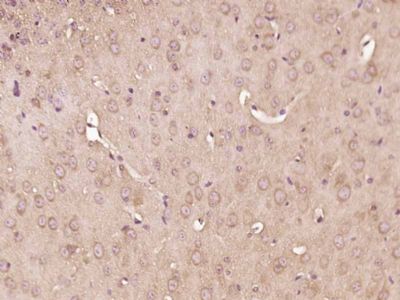RAB10 Polyclonal Antibody
Purified Rabbit Polyclonal Antibody (Pab)
- 产品详情
- 实验流程
Application
| WB, IHC-P, IHC-F, IF, ICC, E |
|---|---|
| Primary Accession | P61026 |
| Reactivity | Rat, Dog |
| Host | Rabbit |
| Clonality | Polyclonal |
| Calculated MW | 22541 Da |
| Physical State | Liquid |
| Immunogen | KLH conjugated synthetic peptide derived from human RAB10 |
| Epitope Specificity | 41-140/200 |
| Isotype | IgG |
| Purity | affinity purified by Protein A |
| Buffer | 0.01M TBS (pH7.4) with 1% BSA, 0.02% Proclin300 and 50% Glycerol. |
| SUBCELLULAR LOCATION | Cytoplasmic vesicle membrane; Lipid-anchor(Probable); Cytoplasmic side (Probable). Golgi apparatus,trans-Golgi network membrane (By similarity). Endosome membrane.Recycling endosome membrane. Cytoplasmic vesicle, phagosomemembrane (By similarity). Cell projection, cilium. Endoplasmicreticulum membrane. Note=Associates with SLC2A4/GLUT4 storagevesicles. Localizes to the base of the cilium. Transientlyassociates with phagosomes (By similarity). According toPubMed:23263280 localizes to the endoplasmic reticulum at domainsof new tubule growth. |
| SIMILARITY | Belongs to the small GTPase superfamily. Rab family. |
| SUBUNIT | Interacts with MYO5A; mediates the transport to theplasma membrane of SLC2A4/GLUT4 storage vesicles. Interacts withGDI1 and maybe with GDI2; negatively regulates RAB10 associationwith membranes and activation. Interacts (GDP-bound form) withLLGL1; the interaction is direct and promotes RAB10 associationwith membranes and activation through competition with the Rabinhibitor GDI1 (By similarity). Interacts with EXOC4; probablyassociates with the exocyst (By similarity). |
| DISEASE | Belongs to the small GTPase superfamily. Rab family. |
| Important Note | This product as supplied is intended for research use only, not for use in human, therapeutic or diagnostic applications. |
| Background Descriptions | The Ras-related superfamily of guanine nucleotide binding proteins, which includes the Ral/Rec, Rap, R-Ras, and Rho/Rab subfamilies, exhibit 30-60% homology with Ras p21 (1). Accumulating data suggests an important role for Rab proteins, either in endocytosis or in biosynthetic protein transport (1,2). The transport of newly synthesized proteins from the endoplasmic reticulum to various stacks of the Golgi complex and to secretory vesicles involves at each stage the movement of carrier vesicles, a process that appears to involve Rab protein function (1-6). The possibility that Rab proteins might also direct the exocytosis from secretory vesicles to the plasma membrane is supported by the observation that in yeast, the SEC4 protein, which is 40% homologous to Rab proteins, is associated with secretory vesicles (9). Several members of the Rab subfamily have been identified, each of which is found at a particular stage of a membrane transport pathway (3-8). |
| Gene ID | 10890 |
|---|---|
| Other Names | Ras-related protein Rab-10, 3.6.5.2, RAB10 |
| Dilution | WB=1:500-2000,IHC-P=1:100-500,IHC-F=1:100-500,ICC=1:100-500,IF=1:100-500,ELISA=1:5000-10000 |
| Format | 0.01M TBS(pH7.4) with 1% BSA, 0.09% (W/V) sodium azide and 50% Glyce |
| Storage | Store at -20 °C for one year. Avoid repeated freeze/thaw cycles. When reconstituted in sterile pH 7.4 0.01M PBS or diluent of antibody the antibody is stable for at least two weeks at 2-4 °C. |
| Name | RAB10 (HGNC:9759) |
|---|---|
| Function | The small GTPases Rab are key regulators of intracellular membrane trafficking, from the formation of transport vesicles to their fusion with membranes (PubMed:21248164). Rabs cycle between an inactive GDP-bound form and an active GTP-bound form that is able to recruit to membranes different set of downstream effectors directly responsible for vesicle formation, movement, tethering and fusion (PubMed:21248164). That Rab is mainly involved in the biosynthetic transport of proteins from the Golgi to the plasma membrane (PubMed:21248164). Regulates, for instance, SLC2A4/GLUT4 glucose transporter-enriched vesicles delivery to the plasma membrane (By similarity). In parallel, it regulates the transport of TLR4, a toll- like receptor to the plasma membrane and therefore may be important for innate immune response (By similarity). Also plays a specific role in asymmetric protein transport to the plasma membrane (PubMed:16641372). In neurons, it is involved in axonogenesis through regulation of vesicular membrane trafficking toward the axonal plasma membrane (By similarity). In epithelial cells, it regulates transport from the Golgi to the basolateral membrane (PubMed:16641372). May play a role in the basolateral recycling pathway and in phagosome maturation (By similarity). May play a role in endoplasmic reticulum dynamics and morphology controlling tubulation along microtubules and tubules fusion (PubMed:23263280). Together with LRRK2, RAB8A, and RILPL1, it regulates ciliogenesis (PubMed:30398148). When phosphorylated by LRRK2 on Thr-73, binds RILPL1 and inhibits ciliogenesis (PubMed:30398148). Participates in the export of a subset of neosynthesized proteins through a Rab8- Rab10-Rab11-dependent endososomal export route (PubMed:32344433). Targeted to and stabilized on stressed lysosomes through LRRK2 phosphorylation where it promotes the extracellular release of lysosomal content through EHBP1 and EHNP1L1 effector proteins (PubMed:30209220). |
| Cellular Location | Cytoplasmic vesicle membrane; Lipid-anchor; Cytoplasmic side. Golgi apparatus membrane. Golgi apparatus, trans-Golgi network membrane {ECO:0000250|UniProtKB:P24409}. Endosome membrane Recycling endosome membrane {ECO:0000250|UniProtKB:P24409}. Cytoplasmic vesicle, phagosome membrane {ECO:0000250|UniProtKB:P24409}. Cytoplasm, cytoskeleton, cilium basal body. Endoplasmic reticulum membrane. Cytoplasm, perinuclear region. Lysosome. Note=Associates with SLC2A4/GLUT4 storage vesicles (PubMed:22908308). Localizes to the base of the cilium when phosphorylated by LRRK2 on Thr-73 (PubMed:20576682, PubMed:30398148). Transiently associates with phagosomes (By similarity). Localizes to the endoplasmic reticulum at domains of new tubule growth (PubMed:23263280). Colocalizes with MICAL1, GRAF1/ARHGAP26 and GRAF2/ARHGAP10 on endosomal tubules (PubMed:32344433). Localizes to enlarged lysosomes through LRRK2 phosphorylation (PubMed:30209220). {ECO:0000250|UniProtKB:P24409, ECO:0000269|PubMed:20576682, ECO:0000269|PubMed:22908308, ECO:0000269|PubMed:23263280, ECO:0000269|PubMed:30209220, ECO:0000269|PubMed:30398148, ECO:0000269|PubMed:32344433} |
| Tissue Location | Expressed in the hippocampus (PubMed:29562525). Expressed in neutrophils (at protein level) (PubMed:29127255) Expressed in the testis (at protein level) (PubMed:28067790) |
Research Areas
For Research Use Only. Not For Use In Diagnostic Procedures.
Application Protocols
Provided below are standard protocols that you may find useful for product applications.
终于等到您。ABCEPTA(百远生物)抗体产品。
点击下方“我要评价 ”按钮提交您的反馈信息,您的反馈和评价是我们最宝贵的财富之一,
我们将在1-3个工作日内处理您的反馈信息。
如有疑问,联系:0512-88856768 tech-china@abcepta.com.
¥ 1,500.00
Cat# AP54435























 癌症的基本特征包括细胞增殖、血管生成、迁移、凋亡逃避机制和细胞永生等。找到癌症发生过程中这些通路的关键标记物和对应的抗体用于检测至关重要。
癌症的基本特征包括细胞增殖、血管生成、迁移、凋亡逃避机制和细胞永生等。找到癌症发生过程中这些通路的关键标记物和对应的抗体用于检测至关重要。 为您推荐一个泛素化位点预测神器——泛素化分析工具,可以为您的蛋白的泛素化位点作出预测和评分。
为您推荐一个泛素化位点预测神器——泛素化分析工具,可以为您的蛋白的泛素化位点作出预测和评分。 细胞自噬受体图形绘图工具为你的蛋白的细胞受体结合位点作出预测和评分,识别结合到自噬通路中的蛋白是非常重要的,便于让我们理解自噬在正常生理、病理过程中的作用,如发育、细胞分化、神经退化性疾病、压力条件下、感染和癌症。
细胞自噬受体图形绘图工具为你的蛋白的细胞受体结合位点作出预测和评分,识别结合到自噬通路中的蛋白是非常重要的,便于让我们理解自噬在正常生理、病理过程中的作用,如发育、细胞分化、神经退化性疾病、压力条件下、感染和癌症。






